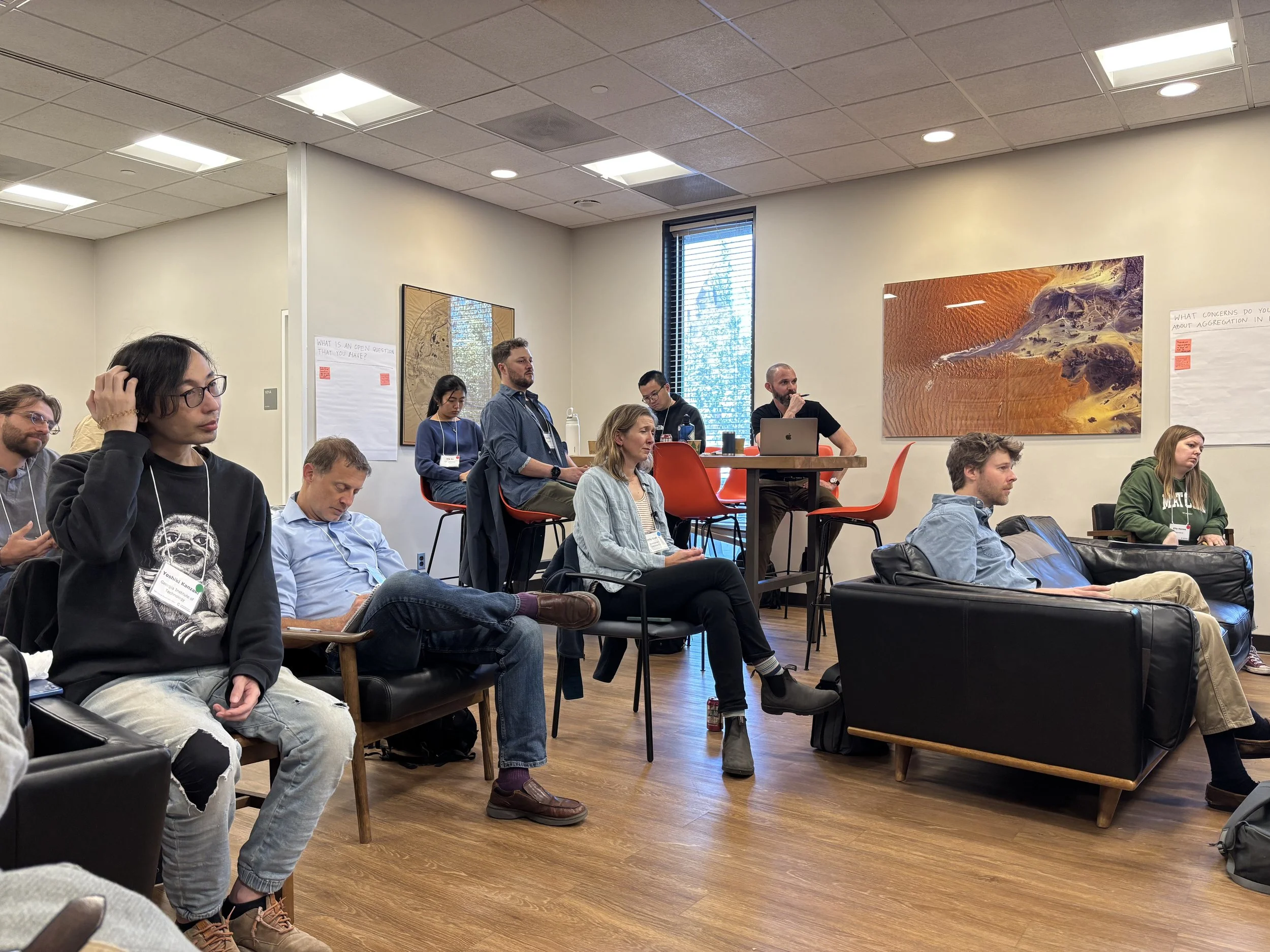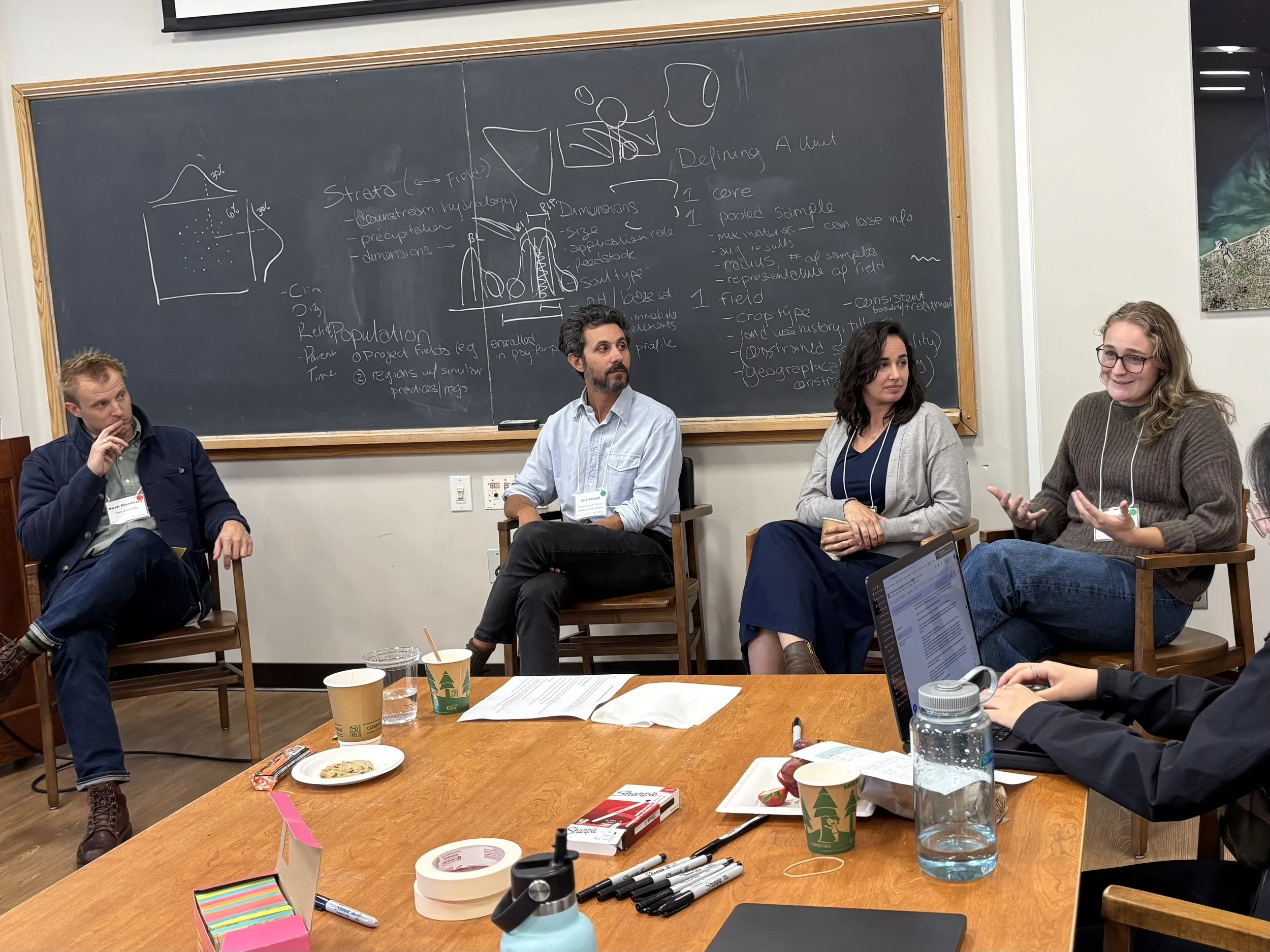Exploring aggregated monitoring
On October 9th, CRSI co-convened a Workshop on Aggregated Monitoring of Enhanced Weathering with the Yale Center for Natural Carbon Capture (YCNCC). We brought together NGOs and academics working on CDR, forestry, and soil organic carbon to generate best practices for quantifying enhanced weathering (EW) at larger scales. In this blog, we’ll dig into the current state of EW quantification, discuss what aggregated monitoring entails, and give a rundown of the workshop.
What is enhanced weathering and how is it quantified?
At a basic level, enhanced weathering involves spreading crushed up rocks and waiting for them to dissolve. EW is typically done on farmlands, and is already a commonplace practice among farmers. Traditionally, EW has involved spreading limestone (ground to pieces roughly the size of sand) on soils. When exposed to water, these bits of rock dissolve, and a chemical reaction takes place that deacidifies soil. Less acidic soil, in turn, can dramatically improve crop yields.
When we think about EW for CDR, our focus shifts from limestone to a different type of rock: silicates. Silicates and limestone have a lot in common. They’re both abundant, relatively inexpensive, can be spread using the same agricultural equipment—and most importantly, both raise soil pH. The key difference between these rocks is that silicates are much better at permanently removing carbon dioxide from the surrounding atmosphere and soil as they dissolve.
Spreading silicates on farmland is relatively intuitive; quantifying exactly how much carbon they remove is trickier. Academic and commercial researchers are actively exploring solid-, liquid-, and gas-phase approaches to gauge carbon removal rates. Significant progress has been made in the last couple of years, but the complexity and natural variability of these agroecosystems make it hard to arrive at a very precise estimate of carbon removal from a single field, even with lots of measurements.
The case for aggregation
Aggregating EW measurements from multiple fields can be a powerful way to improve the precision of an overall CDR estimate. By aggregating, we mean combining measurements from a defined set of EW fields. A recent pre-print featuring authors from workshop co-conveners YCNCC and CRSI explored the potential for aggregated monitoring across solid-, liquid-, and gas-phase approaches to quantifying EW. Simulation results from this preprint show that, when you combine fields, a lot of the natural variability “comes out in the wash” — uncertainty (and the risk of overcrediting) decreases as you aggregate over a larger and larger number of fields. Perhaps unsurprisingly, how you decide to aggregate these fields is extremely consequential. Thankfully, there is lots we can learn from how other CDR pathways have implemented aggregated monitoring.
Soil organic carbon (SOC) and forestry are two approaches to CDR that have been around the longest. They are both quite mainstream in today’s carbon markets with projects that span huge areas of land, much larger than today’s EW deployments. Carbon crediting practices for these CDR pathways have evolved and improved significantly over the last five years, including the adoption of more sophisticated methods for determining controls, baselines, and equivalence between areas. There’s a lot that EW practitioners can learn from what has and hasn’t worked elsewhere. This was a driving force behind partnering with YCNCC to co-convene a workshop about the SOC and forestry aggregated monitoring practices that do and don’t translate to EW.
Highlights from the workshop
Participants explored both idealized and practical strategies to aggregate EW measurements from different deployment sites and how this might change over time as EW gains broader adoption as an agronomic practice. The day began with opening remarks on EW quantification (Professor Noah Planavsky), potential for aggregation (Dr. Tim Jesper Suhrhoff), and policy context (Anu Khan).
Breakouts followed, where groups talked about idealized (e.g., “in a perfect world”) aggregated monitoring of EW. A shareout from these conversations reflected the importance of delineating spatial areas of aggregation, agreeing on stratification practices for aggregation, determining best baselining practices, solving for accuracy and precision, addressing how measurement practices affect variance, and gathering real-world data on the effects of aggregating EW measurements.
After lunch, a panel featuring Dr. Eric Potash (University of Illinois, Urbana-Champagne), Dr. Rebecca Sanders-DeMott (Clean Air Task Force), Ella Milliken (Yale University), and Noah Planavsky (Yale University; moderator) explored how EW, SOC, and forestry projects compare in terms of size, data generation and reliance on external data, and attribution of removals to specific areas within aggregated projects.
We then returned to the same breakout groups from the morning, focused on practical implementation of aggregated monitoring for EW. The afternoon session specifically explored sampling densities, inclusion and exclusion of EW fields in aggregation, uncertainty at various scales, and how prescriptive versus deferential to be on aggregated monitoring guidance. After this second breakout session, the group reconvened for a closing plenary, where a set of guiding principles for aggregated monitoring was discussed.
Establishing best practices for aggregation is a valuable step to scale EW while continuing to improve the accuracy of measurements. Approaches to aggregated monitoring will need to accommodate different purposes (e.g., carbon crediting versus pay-for-practice policy contexts). To move toward these goals, the key takeaways from our workshop will be distilled into a perspective piece on the “do’s and don’ts of aggregated monitoring of enhanced weathering,” publishing next year.
We’d like to give a huge thank you to our attendees and to the YCNCC and the Yale Earth & Planetary Sciences Department for generously supporting the workshop.
CarbonPlan, Carbon Removal Standards Initiative, Carbontech Consulting, Cascade Climate, Clean Air Task Force, Environmental Defense Fund, Georgia Institute of Technology, Isometric, New York University, University of Illinois, Urbana-Champaign, Yale Center for Natural Carbon Capture, Yale Department of Earth & Planetary Sciences, Yale School of the Environment, 350Solutions
Edited by Emily Reich. Cover image by Rod Long.





